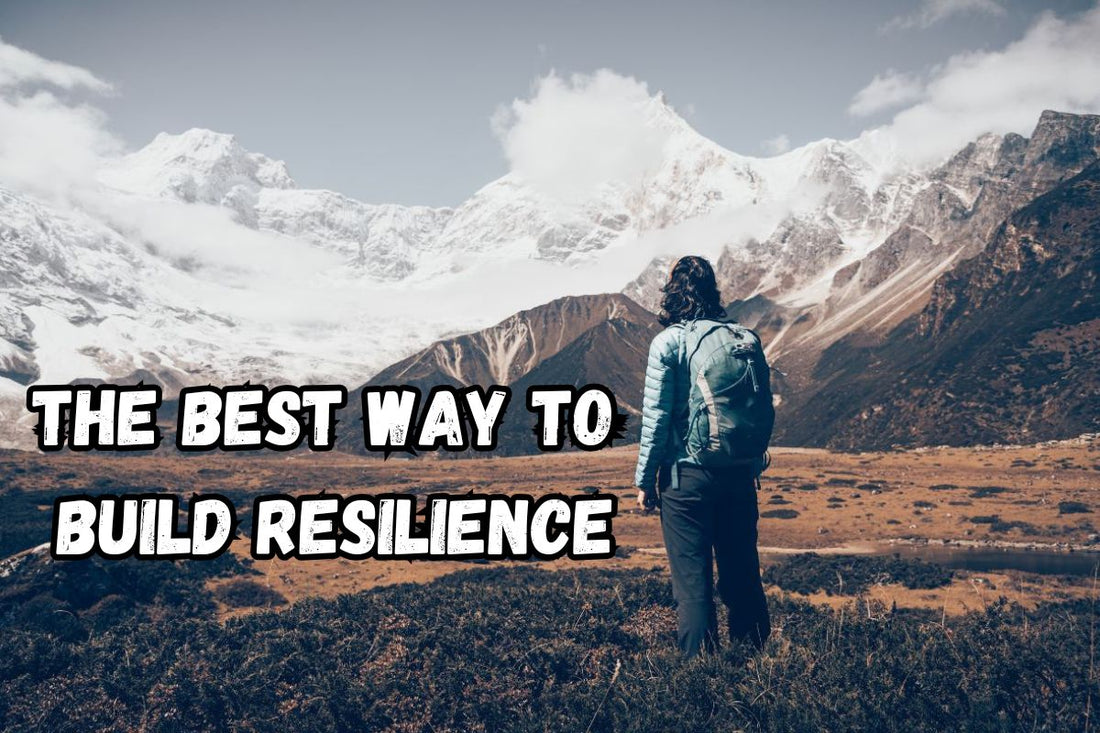TLDR: How to Build Emotional Resilience
- Assess and Strengthen Resilience – Regularly evaluate your resilience and work on improvement.
- Enhance Self-Awareness – Identify stress triggers and adjust your responses.
- Adopt a Positive Mindset – Replace negative thoughts with constructive alternatives.
- Practice Gratitude – Focus on what’s going well by keeping a gratitude journal.
- Use Stress Management Techniques – Meditation, deep breathing, and mindfulness help regulate emotions.
The Best Way to Build Emotional Resilience
What is Emotional Resilience?
 Emotional resilience is the ability to bounce back from life’s challenges, stress, and setbacks. It’s the ability to take life by the horns so you don’t mess with the bull… or something to that effect. It helps us stay strong, adapt, and keep moving forward even when things get tough. And if there’s one thing I can guarantee in life, it will get rough. Some key traits of emotionally resilient people include:
Emotional resilience is the ability to bounce back from life’s challenges, stress, and setbacks. It’s the ability to take life by the horns so you don’t mess with the bull… or something to that effect. It helps us stay strong, adapt, and keep moving forward even when things get tough. And if there’s one thing I can guarantee in life, it will get rough. Some key traits of emotionally resilient people include:
- Self-acceptance – Understanding and embracing your talents as well as your flaws.
- Stress management – Using healthy coping mechanisms.
- Self-esteem – Believing in your own worth and abilities.
- Mindfulness – Staying focused on the present moment.
- Emotional awareness – Recognizing and managing emotions effectively.
- Healthy reactions to stress – Responding in ways that support well-being.
Emotional resilience is not something you are born with. It is not an inherited trait passed down from your great-great-great-grandmother twice removed on your father’s side. The good news? Anyone can build emotional resilience with practice. Let’s dive into the best ways to strengthen your emotional resilience and handle life’s ups and downs with confidence.
Note: Emotional resilience is a skill, and like any skill, it takes time and repetition to build. It’s important to be patient and give yourself some grace as you form new habits.
The Best Exercises to Build Emotional Resilience
1. Take a Resilience Self-Assessment
Gauge your current emotional resilience by rating yourself on these statements (0 = Strongly Disagree, 5 = Strongly Agree):
- I trust myself.
- I am proud of my achievements.
- I have the strength to overcome difficulties.
- I focus on solutions more than problems.
- I enjoy my life.
If you scored between 31-50, congrats, you have high resilience. If your score is lower, don’t panic! It just means you’ve got some room to improve, and you can focus on building resilience through the steps in this post.
2. Improve Self-Awareness

The first step in solving a problem is realizing you have one, kind of like when you walk into a room and forget why you’re there. Most people go through life with their subconscious in the driver’s seat, cruising on autopilot, completely unaware that their negative habits are running the show. Recognizing how you react to stress is the first step to managing it. Use the A-B-C method:
- A (Antecedent): What triggered the stress?
- B (Behaviour): How did you react?
- C (Consequence): What was the result of your reaction?
By analyzing this pattern daily, over time you can learn to respond to stress in healthier ways.
3. Develop a Positive Mindset

Negativity can drain your energy and make stress feel overwhelming. Instead of letting negative thoughts take over, try checking yourself before you wreck yourself, also known as the double-column thought replacement method:
- In one column, write down five negative thoughts bothering you.
- In the second column replace each with a positive or solution-focused alternative.
For example, change “I’ll never get through this” to “I’ve handled tough situations before; I can do it again.”
 My Story
My Story
This one was vital in my recovery. The following picture was taken three hours after I had woken up from my induced coma, and as you can see by the ridiculous grin on my face, I was elated. I thought I had died, so having a second chance at life was incredible.
The thoughts in my head were ones of gratitude: "I'm alive. I get to see my family again." "I get to be with my wife of only five days again." Because my thoughts were focused on the positives in my life, despite the pain I was in, I was genuinely happy.
Once my family had left for the night and I was alone in the ICU, my thoughts quickly shifted as reality hit me like a ton of bricks. I became angry and bitter at myself for making such a huge mistake and blowing myself up. "You're a moron, Levi! How are you going to be a good father or husband? You’re a musician with no left hand, you’ve ruined your life." I berated myself with thoughts like these for over five hours.
Finally, once I had no more tears to shed over my situation, another reality slapped me across the face, harder than Chris Rock at the Academy Awards. My thoughts shifted again: "Levi, you don’t have your left hand, but you still have your right hand. You may be having a hard time seeing and hearing, but you can still see and hear. You may be struggling to breathe, but guess what? You’re breathing. You are alive! What are you complaining about? Life is good."
And once again, I felt the warmth and joy of gratitude fill my soul, and once again, I was genuinely happy.
The crazy thing? My situation throughout that roller coaster of emotions never changed. I was in the same bed, in the same room, in the most pain I had ever experienced in my life. So what changed to cause such drastic highs and lows of emotions? My thoughts.
It’s all about learning to control your thoughts in order to redirect your emotions. It’s normal and natural to feel negative emotions, but how long you stay there is entirely your choice.

4. Practice Gratitude
I know it feels cliché, but honestly, gratitude shifts your focus from what’s going wrong to what’s going right. Similar to the double-column method, gratitude can be used in the moment to redirect negative emotions. A simple yet effective way to practice gratitude is by keeping a gratitude journal. Every day or week, write down:
- Three people you’re grateful for.
- Five goals you accomplished.
- Good things that happened recently.
This habit of “focusing on the positive” helps train your brain to see the positives, making you more emotionally resilient over time.
5. Practice Meditation and Stress Management

Meditation might sound like a bunch of gobbledygook nonsense, but really, it’s just giving yourself a moment to exist without your brain running around like a caffeinated squirrel. And guess what? It actually helps! It calms your mind, regulates emotions, and, best of all, requires zero wheatgrass shots or Jamba Juice. Try:
- Deep breathing – Inhale for four seconds, hold for four, exhale for four.
- Awareness Meditation – Sit quietly, focus on your breath, and observe your thoughts without judgment.
- Progressive muscle relaxation – Tense and relax different muscle groups to release stress.
The Importance of Emotional Resilience

Emotional resilience is essential because:
- It keeps you from losing your mind over minor inconveniences. Because no one wants to have a full existential crisis just because they spilled their coffee.
- It helps you walk into a room like you own the place (even if you just tripped on the way in). Confidence is key, and resilience makes sure you bounce back from awkward moments like a pro.
- It stops you from sending that “I’m fine” text when you’re absolutely not fine. Emotional resilience helps you handle conflicts without passive-aggressively slamming cabinet doors.
- It makes life’s chaos feel more like a sitcom and less like a disaster movie. When things go wrong, you’ll roll with the punches instead of dramatically announcing, “I can’t do this anymore” (for the third time this week).
Building resilience is a journey, but with consistent effort, you can strengthen your ability to navigate life’s obstacles with greater ease. Keep at it, and soon, you’ll be handling stress like a monk.
FAQs About Emotional Resilience
What are the key elements of emotional resilience?
The key elements include physical health, mental strength, social connections, and emotional regulation.
Can emotional resilience be learned?
Yes. It takes practice, but anyone can develop resilience through mindset shifts, self-awareness, and healthy coping strategies.
How can I build resilience at work?
Focus on work-life balance, manage stress through practicing awareness, and build strong workplace relationships.
Does emotional resilience mean ignoring negative emotions?
No, resilience is about processing emotions in a healthy way, not suppressing them.
How long does it take to build emotional resilience?
It varies for everyone, but small, consistent efforts can lead to noticeable improvements within weeks or months.
FAQs About Levi Stanford
Who is Levi Stanford?
Levi Stanford is a Canadian motivational speaker, comedian, and musician who inspires and entertains people through his work.
What topics does Levi Stanford cover?
Levi speaks on emotional resilience, personal growth, and overcoming challenges, often blending humour and music into his presentations.
How can I book Levi Stanford for an event?
For booking inquiries, visit the “Contact” tab in the above website menu or contact his team directly by emailing levi@levistanford.com
Does Levi Stanford offer coaching or workshops?
Yes, Levi provides motivational coaching and workshops on resilience, mindset, and personal development.
Where can I follow Levi Stanford’s work?
You can follow Levi on social media for insights, updates, and upcoming events.
Building emotional resilience takes time and effort, but it’s worth it. Start with small changes today, and over time, you’ll become stronger, more confident, and better equipped to handle whatever life throws your way.







